Digital art is increasingly popular, yet it presents unique challenges related to copyright, market competition, and pricing strategies. Artists must carefully navigate ownership and reproduction rights to protect their work from infringement, while also adapting to a rapidly evolving marketplace filled with diverse platforms. Understanding these dynamics is essential for establishing a successful presence in the digital art world.
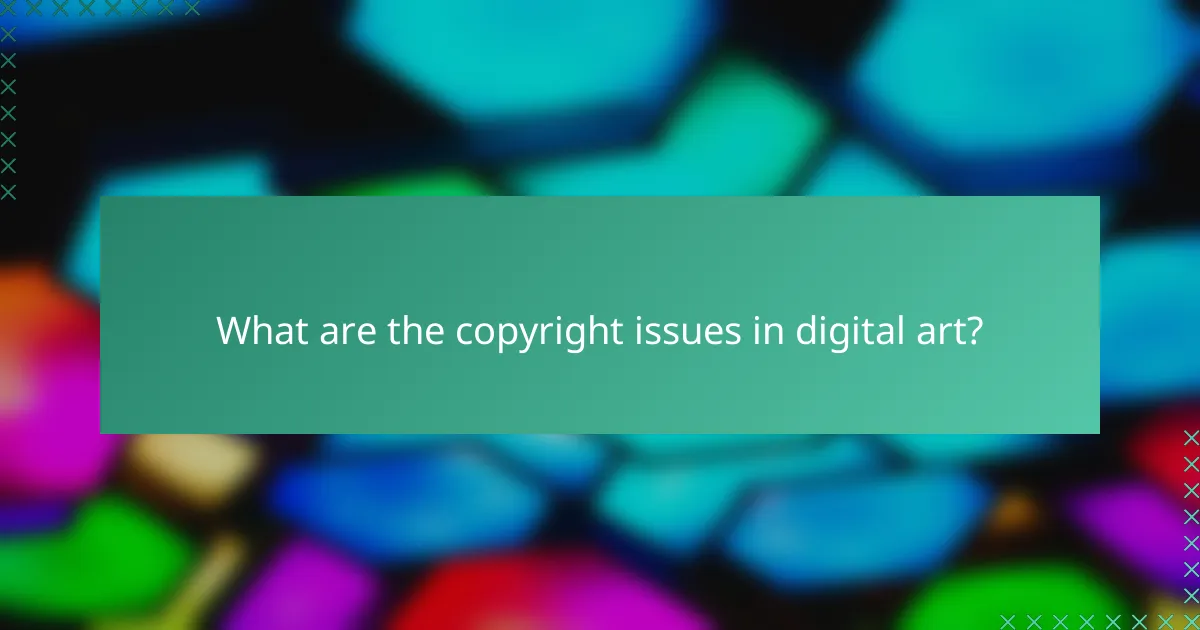
What are the copyright issues in digital art?
Copyright issues in digital art primarily revolve around ownership, reproduction rights, and the potential for infringement. Artists must navigate these complexities to protect their work while understanding how their creations can be used by others.
Copyright infringement risks
Copyright infringement occurs when someone uses a digital artwork without permission from the creator. This can include unauthorized reproduction, distribution, or display of the artwork, which can lead to legal consequences and financial losses for the artist.
To mitigate risks, artists should monitor the use of their work online and consider using digital watermarks or copyright notices. Educating oneself about the legal framework surrounding copyright can also help in recognizing and addressing potential infringements.
Fair use considerations
Fair use is a legal doctrine that allows limited use of copyrighted material without permission under certain circumstances. In digital art, this can apply to transformative works, commentary, or educational purposes, but the boundaries of fair use can be ambiguous.
Artists should evaluate whether their use of another’s work meets the criteria for fair use, considering factors like the purpose of use, the nature of the original work, the amount used, and the effect on the market value of the original. Consulting legal advice can provide clarity in complex situations.
Licensing agreements
Licensing agreements are contracts that grant permission to use a digital artwork under specified conditions. These agreements can define how the artwork can be used, whether for commercial purposes or personal projects, and can include terms regarding royalties or attribution.
Artists should clearly outline their licensing terms to avoid misunderstandings and ensure fair compensation. Standard licensing models include exclusive and non-exclusive licenses, and artists should choose the model that best aligns with their goals and market strategy.
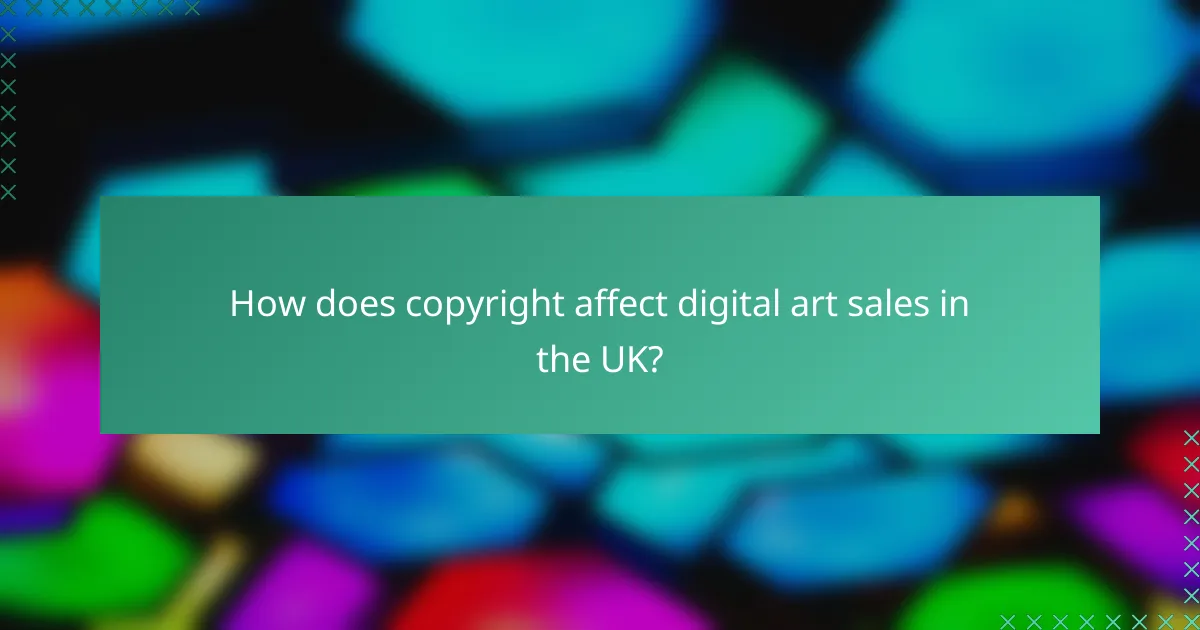
How does copyright affect digital art sales in the UK?
Copyright significantly influences digital art sales in the UK by protecting the creator’s rights while also shaping market dynamics. Artists must navigate copyright laws to ensure their work is not misused, which can impact pricing and accessibility.
Impact on pricing strategies
Copyright affects pricing strategies by allowing artists to set higher prices for original works due to their protected status. When an artist holds exclusive rights, they can leverage this to negotiate better deals, often resulting in prices that reflect the uniqueness and legal protection of the artwork.
Conversely, if an artist’s work is frequently pirated or misappropriated, it may lead to a decrease in perceived value, forcing them to lower prices to remain competitive. Artists should consider the balance between exclusivity and market demand when setting their prices.
Market access limitations
Copyright can create market access limitations by restricting how digital art can be shared or sold. Artists may face challenges if they want to collaborate or distribute their work through various platforms, as they must ensure compliance with copyright regulations.
Additionally, potential buyers may be deterred from purchasing digital art if they are uncertain about copyright ownership and usage rights. Clear communication about these rights can enhance market access and encourage sales, helping artists to navigate the complexities of copyright effectively.
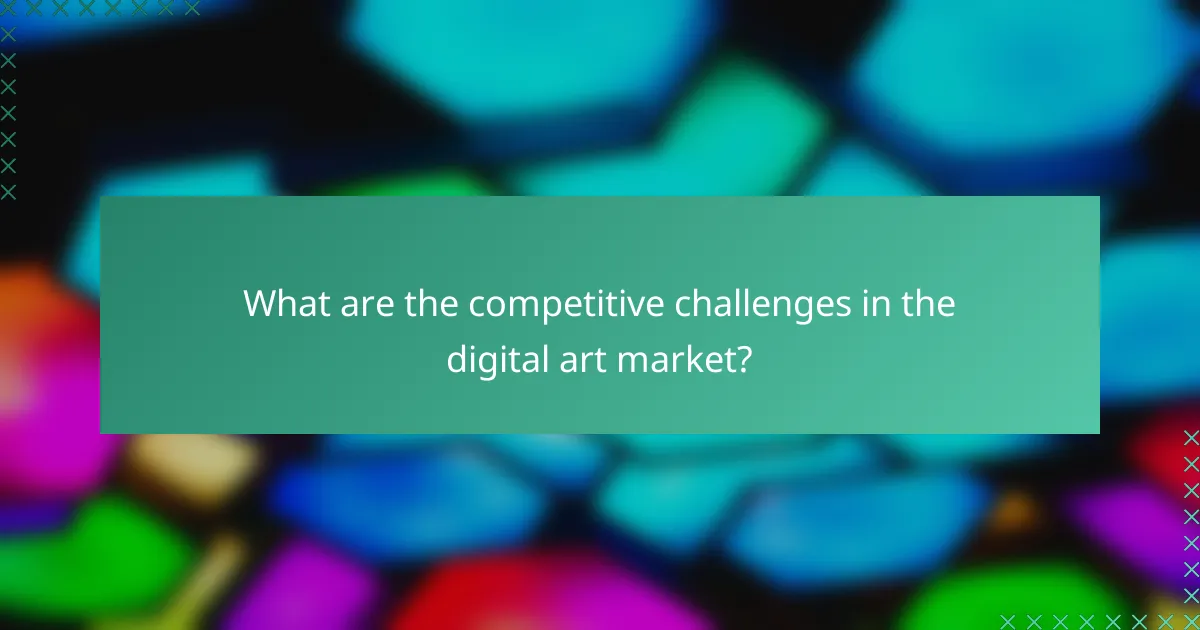
What are the competitive challenges in the digital art market?
The digital art market faces several competitive challenges, including the rise of new platforms and the ongoing rivalry with traditional art forms. Artists must navigate a landscape filled with diverse marketplaces, pricing strategies, and copyright issues to establish their presence and profitability.
Emerging platforms like OpenSea
Emerging platforms such as OpenSea have transformed how digital art is bought and sold, introducing unique opportunities and challenges. These marketplaces allow artists to reach global audiences, but they also increase competition as countless creators vie for attention.
Artists should consider the fees associated with these platforms, which can vary significantly. For example, OpenSea charges a commission on sales, typically around 2.5%, which can impact pricing strategies. Understanding the fee structure is crucial for setting competitive prices while ensuring profitability.
Traditional vs. digital art competition
The competition between traditional and digital art is becoming increasingly pronounced, with each medium appealing to different audiences. Traditional art often commands higher prices due to its physical nature and established market, while digital art offers lower entry costs and broader distribution.
Artists should assess their unique value propositions when competing in this dual market. For instance, digital artists can leverage social media for marketing and engage directly with their audience, which can enhance their visibility and sales potential. However, they must also be aware of copyright issues that can arise from reproducing or selling digital works.
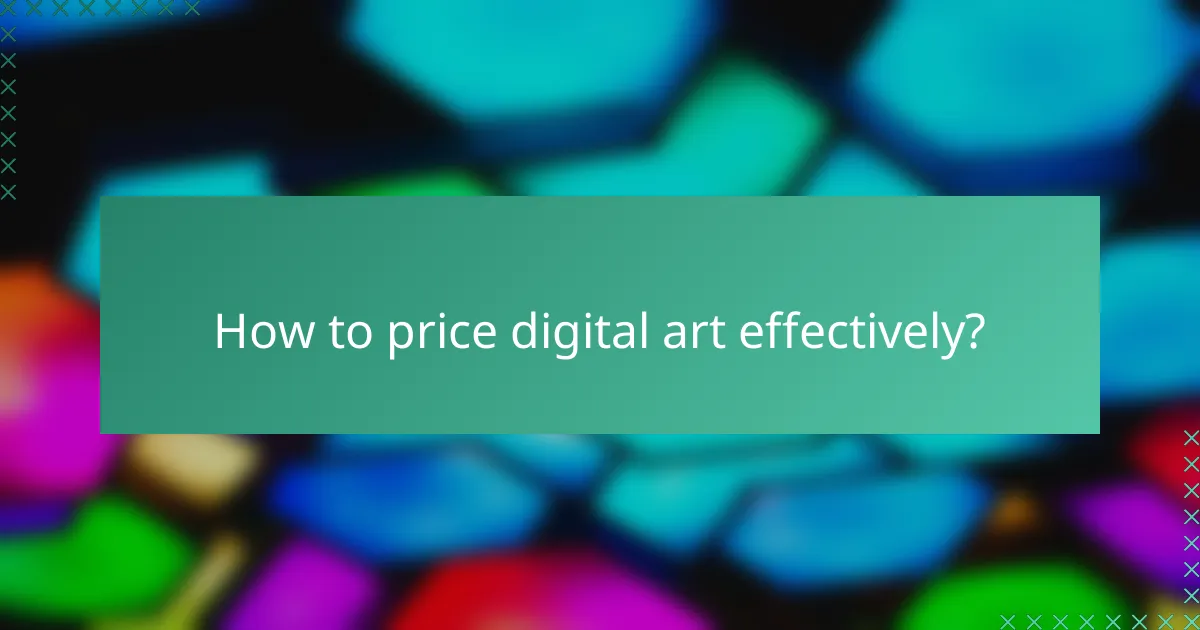
How to price digital art effectively?
To price digital art effectively, consider factors such as your experience, the complexity of the work, and market trends. Setting a price that reflects both your skill level and the demand for your art will help you attract buyers while ensuring fair compensation.
Factors influencing pricing
Several key factors influence the pricing of digital art. Your experience and reputation play a significant role; established artists can command higher prices than newcomers. Additionally, the complexity and time required to create the artwork should be factored in, as more intricate pieces typically warrant higher prices.
Another important consideration is the medium and style of your digital art. For example, illustrations may be priced differently than digital paintings or animations. Lastly, the exclusivity of the piece, such as whether it is a one-of-a-kind work or part of a series, can significantly affect its value.
Market demand analysis
Understanding market demand is crucial for effective pricing of digital art. Research current trends in the digital art market to identify what styles and themes are popular among buyers. Platforms like Etsy, ArtStation, and social media can provide insights into what types of art are selling well.
Consider conducting surveys or engaging with your audience to gauge their interest in your work. Pricing your art competitively based on demand can help you attract more buyers. Keep an eye on similar artists’ pricing strategies to ensure your rates are in line with market expectations, while still reflecting your unique value.

What are the best practices for protecting digital art?
To protect digital art, artists should implement a combination of watermarking techniques and digital rights management tools. These practices help safeguard their work from unauthorized use and ensure they retain control over their creations.
Watermarking techniques
Watermarking involves embedding a visible or invisible mark onto digital artwork to deter theft and unauthorized distribution. Visible watermarks can be logos or text placed strategically on the image, while invisible watermarks use digital coding that can be detected by specific software.
When applying visible watermarks, consider placing them in a way that does not detract from the artwork’s appeal but is still noticeable. For example, a semi-transparent logo in a corner can serve as a deterrent while maintaining the integrity of the piece.
Digital rights management tools
Digital rights management (DRM) tools help artists control how their digital art is used and distributed. These tools can restrict copying, sharing, or printing of the artwork, providing an additional layer of protection against unauthorized use.
Popular DRM solutions include platforms that allow artists to license their work, track usage, and enforce copyright. Artists should evaluate different options based on their specific needs, such as ease of use, cost, and the level of protection offered. Regularly updating and reviewing these tools is essential to adapt to evolving market conditions and technology.
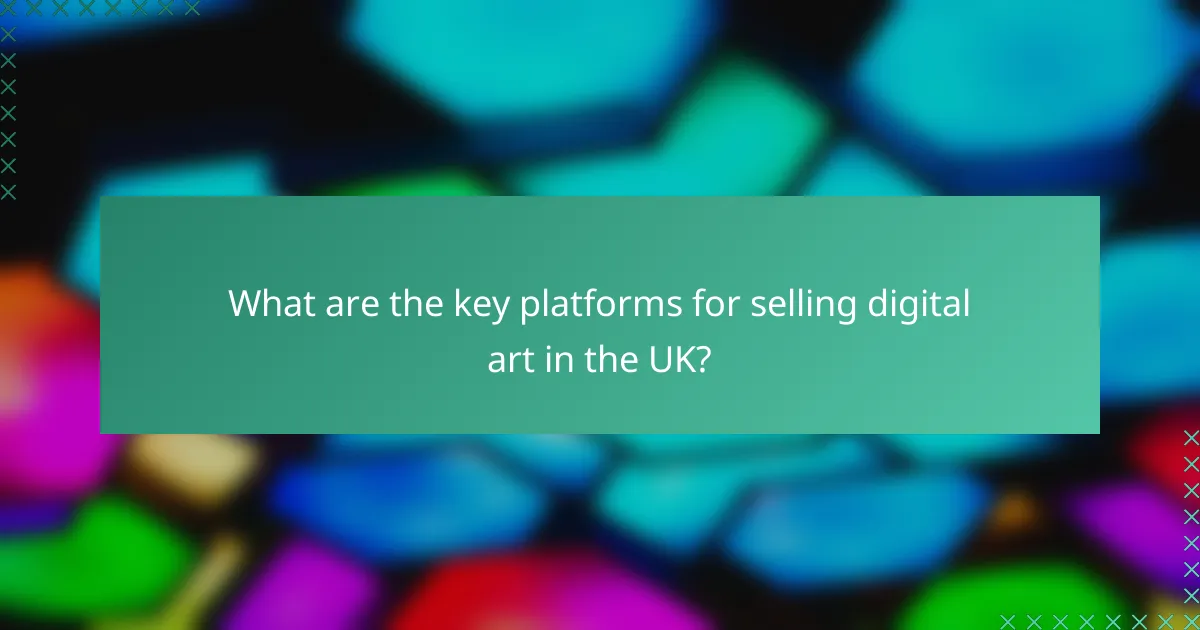
What are the key platforms for selling digital art in the UK?
In the UK, several platforms cater specifically to digital artists looking to sell their work. These platforms offer various features, pricing structures, and audience reach, making it essential for artists to choose the right one for their needs.
Platforms like Etsy
Etsy is a popular marketplace for artists and creators, allowing them to sell digital art directly to consumers. Artists can set up their shops, list their digital products, and benefit from Etsy’s large user base, which is particularly interested in handmade and unique items.
When using Etsy, consider the listing fees and transaction costs, which can impact your pricing strategy. It’s important to optimize your product descriptions and tags to improve visibility in search results, as competition can be high.
Marketplaces such as Saatchi Art
Saatchi Art is a well-known platform that focuses on fine art, including digital pieces. It provides artists with a global audience and handles aspects like payment processing and shipping, which can simplify the selling process.
Artists on Saatchi Art can benefit from the platform’s marketing efforts and curated collections, but they should be aware of the commission fees that apply to sales. To maximize success, ensure your portfolio is well-presented and showcases your best work, as the platform emphasizes quality and artistic merit.

How do emerging technologies impact digital art?
Emerging technologies significantly influence digital art by reshaping creation, ownership, and distribution methods. Innovations like blockchain and artificial intelligence introduce new opportunities and challenges for artists and collectors alike.
Role of NFTs in ownership
Non-fungible tokens (NFTs) have revolutionized ownership in the digital art space by providing a unique, verifiable proof of authenticity and ownership. Artists can mint their works as NFTs, allowing them to sell directly to collectors while retaining control over their creations.
However, artists should consider the environmental impact of blockchain technologies and the varying fees associated with minting NFTs on different platforms. It’s essential to choose marketplaces that align with their values and offer favorable terms.
AI-generated art trends
AI-generated art is gaining traction, enabling artists to explore new creative avenues and produce works that blend human creativity with machine learning. Tools like DALL-E and Midjourney allow users to generate unique images based on text prompts, expanding the possibilities of digital art.
While AI can enhance creativity, artists must navigate copyright issues surrounding AI-generated content. Understanding the ownership rights of AI-generated works and the implications of using AI tools is crucial for artists looking to integrate these technologies into their practice.
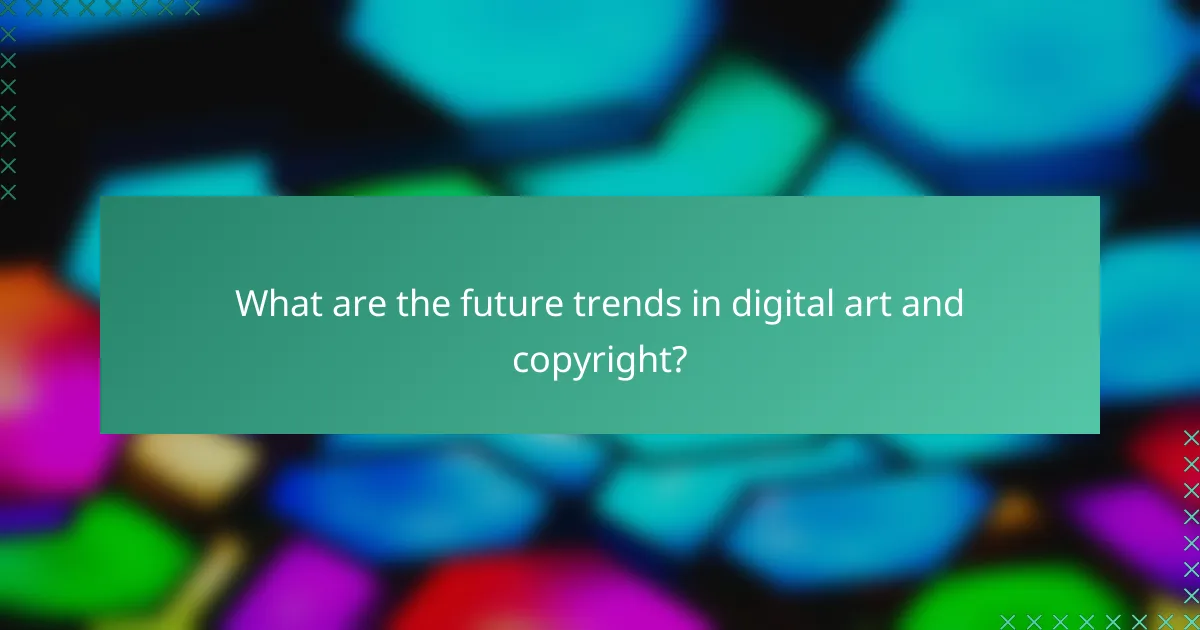
What are the future trends in digital art and copyright?
The future of digital art and copyright will likely see increased regulation and evolving market dynamics. Artists and creators must stay informed about ownership rights and the competitive landscape to navigate these changes effectively.
Increased regulation on digital ownership
As digital art gains prominence, regulatory bodies are likely to implement stricter rules regarding digital ownership. This could include clearer definitions of copyright, licensing agreements, and the rights of creators versus consumers.
Artists should be aware of how these regulations can affect their work. For instance, platforms may require more comprehensive licensing agreements that specify how digital art can be used, shared, or sold. Understanding these terms is crucial to protecting one’s intellectual property.
To avoid pitfalls, artists should consider consulting with legal professionals who specialize in intellectual property. This can help ensure that their rights are safeguarded and that they are compliant with any new regulations that may emerge.
